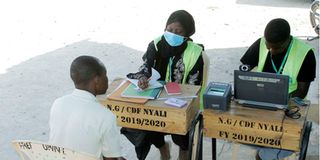Concerns as analysis of voter roll exposes ‘suspect’ transfers

A man registers as a voter at Kwa Bulo Primary School in Mombasa on January 31. Garissa, Mandera, Wajir, Marsabit, Isiolo and Tana River witnessed huge transfer of voters.
New data by the electoral commission has exposed mysterious transfer of voters in at least six counties, raising questions on the credibility of the register ahead of the General Election on August 9.
Analysis of the voter registration shows there was a national average of five per cent in transfers during the enhanced continuous voter registration. But some counties the analysis by Saturday Nation has flagged up recorded as high as 29 per cent.
Counties affected include Garissa, Mandera, Wajir, Marsabit, Isiolo and Tana River. More scrutiny reveals that the same regions recorded the highest new registrations at 28 per cent, compared to the national average of 14.
The Independent Electoral and Boundaries Commission (IEBC) last evening postponed a press briefing in which it was to make public the audit of the voter roll.
The commission on Thursday announced that it would make the audit by KPMG public as part of its preparations in responding to concerns that the register could have loopholes that may influence the election outcome.
“Today’s press briefing on the audit of the register of voters scheduled at the Bomas of Kenya, Nairobi, at 6pm has been postponed until June 20 at the same venue,” the statement said yesterday. “The commission is yet to receive the final audit report from KPMG. Commissioners are unavailable due to Dispute Resolution Committee hearings at Milimani Law Courts.”
A total of 50,328 voters were transferred in Mandera county.
The figure is more than the number of voters registered between 2017 and 2022, which IEBC places at 40,210.
Mandera’s total number of registered voters as per the 2017 audited roll was at 175,650, meaning the new transfers represent 29 per cent. The figure is more than registered voters in a single constituency in Mandera, a county with six electoral areas.
But Economic Freedom Party chairman Isaac Abey linked the transfers in Mandera to ethnic interests, where members of a particular community have ended up transferring their votes to a particular electoral area to consolidate their numbers.
“Some people have moved because of nepotism and general disappointment in the current administration. There are also intra-county transfers. Everyone is trying to move to where their interests are secured,” Mr Abey said.
In Garissa, some 41,513 voters transferred in the same period it recorded 46,241 new ones. The county had 163,350 registered voters in the run-up to the 2017 polls. The total transfers represent 25 per cent of voters in 2017.
It is the same case in Wajir, which recorded 32,190 transfers after registering 35,964 voters.
The county had 162,912 voters in 2017, meaning it had 20 per cent transfer.
Marsabit recorded 24, 546 new voters and 14, 263 transfers that represent 10 per cent of the 141,730 voters in the 2017 audited register. A total of 11,567 new voters were enlisted in Isiolo county when 9,731 transferred their electoral areas.
Also Read: Inside Raila’s 10-point demands to IEBC
Tana River recorded 11,599 transfers even as the region got 20,635 new voters.
Nationally, the commission recorded 1,068,444 transfers during the registration period that also saw the listing of 2,743,498 voters. The IEBC shared the data in its letter to Azimio la Umoja One Kenya coalition party, giving a breakdown of transfers.
In absolute numbers, Nairobi recorded the highest number of transfers at 125,867, representing six per cent of its 2017 register. It was followed by Nakuru at 57,466 (six per cent) and Kiambu 50,438 (four per cent).
Two weeks ago, the IEBC admitted that there could have been irregular voter transfers, directing investigations into any possible external interference or collusion by its officials. A May 25 internal memo by the agency said preliminary analysis of the register revealed that there could be some transfers effected without the supporting statutory forms.
At the same time, the data has revealed consistent low registration turnout in most Mt Kenya counties that politicians in Kenya Kwanza Alliance have since linked to an alleged enlisting suppression. Nyandarua (28,225), Nyeri (35,355), Murang’a (44,386) and Laikipia (20,499) recorded eight per cent new voters against the nationwide average of 14 per cent, while Kirinyaga recorded nine per cent (30,449).
Kiambu and Nakuru, however, recorded 10 per cent (119,937) and 12 per cent (111,503) respectively. Deputy President William Ruto recently claimed that one million registered voters in his strongholds had been removed from the roll.
“We expect everybody who is concerned, including the EU, to try and get as much detail as possible both from the electoral commission and these public officials on what all this is all about and how did close to a million names disappear from the register. And many of those names are from what we consider our stronghold,” he said during a meeting with European Union (EU) envoys.





